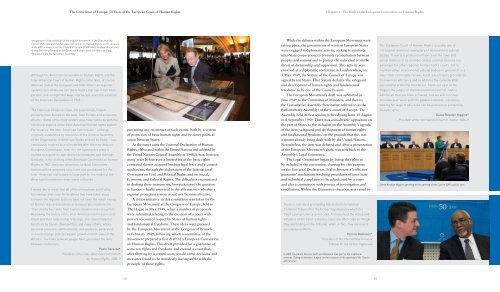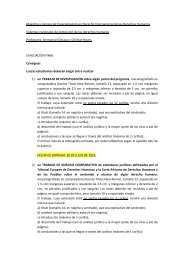Historia Corte Europea
Create successful ePaper yourself
Turn your PDF publications into a flip-book with our unique Google optimized e-Paper software.
The Conscience of Europe: 50 Years of the <strong>Europea</strong>n Court of Human Rights<br />
Chapter 1: The Birth of the <strong>Europea</strong>n Convention on Human Rights<br />
Inauguration of the exhibition of the original documents of the Statute of the<br />
Council of Europe and the <strong>Europea</strong>n Convention on Human Rights, on the occasion<br />
of the 60th anniversary of the Council of Europe (2009). Maud de Boer-Buquicchio,<br />
Acting Secretary General of the Council of Europe, and Lluís Maria de Puig,<br />
President of the Parliamentary Assembly.<br />
Although the American Convention on Human Rights and the<br />
Inter-American Court of Human Rights came later, of course,<br />
when we look at the <strong>Europea</strong>n and Inter-American regional<br />
systems as a whole, we can see a history that has in fact been<br />
parallel, and in important ways intertwined, since the adoption<br />
of the American Declaration in 1948 …<br />
The historical influences have, not surprisingly, flowed<br />
primarily from Europe to the west, from Europe and across the<br />
Atlantic. Some of the most evident ones have had to do with the<br />
structural aspects of the Inter-American human rights system.<br />
For instance, the Inter-American Commission – although<br />
originally established by resolution of the General Assembly<br />
of the Organization of American States and not by treaty – was<br />
consciously inspired by and modelled after the now-defunct<br />
<strong>Europea</strong>n Commission, even if in the subsequent years it<br />
evolved to acquire its own distinctive mandates and methods.<br />
Similarly, in the drafting of the American Convention on Human<br />
Rights in 1967, the Inter-American Juridical Committee<br />
fashioned their proposed structures and procedures for the<br />
Inter-American institutions in large part on the model of the<br />
American Convention’s elder sister in Europe …<br />
I would like to recall that all of the interactions and fruitful<br />
borrowings and cross-fertilizations that have taken place<br />
between the regional systems have not been the result merely<br />
of formal rules and practices or bureaucratic mechanisms.<br />
Their vitality has come from human relations and encounters.<br />
Reviewing the history of the Inter-American Commission and<br />
Court and their relationship to Europe, one cannot help but<br />
be struck by Cassin, Buergenthal, and many others, whose<br />
personal presence, commitments, and openness generated<br />
rich interchange and consequent growth on both sides of the<br />
Atlantic. The links between people have generated the links<br />
between institutions.<br />
Paolo Carozza*<br />
President of the Inter-American Commission<br />
on Human Rights, 2008–9<br />
preventing any recurrence of such events, both by a system<br />
of protection of basic human rights and by closer political<br />
union between States.<br />
At the outset came the Universal Declaration of Human<br />
Rights, elaborated within the United Nations and adopted by<br />
the United Nations General Assembly in 1948. It was, however,<br />
many years before even a limited list of the basic rights<br />
contained therein acquired binding legal force and a control<br />
mechanism, through the elaboration of the International<br />
Covenants on Civil and Political Rights and on Social,<br />
Economic and Cultural Rights. The difficulties encountered<br />
in drafting these instruments, however, raised the question<br />
in Europe – finally answered in the affirmative – whether a<br />
regional protection system would not be more effective.<br />
A major initiative in this connection was taken by the<br />
<strong>Europea</strong>n Movement at the Congress of Europe, held in<br />
The Hague in May 1948, when a number of proposals<br />
were submitted relating to the creation of a court with<br />
powers to control respect by States of human rights<br />
and fundamental freedoms. These ideas were pursued<br />
by the <strong>Europea</strong>n Movement at the Congress of Brussels<br />
in February 1949, following which a committee of the<br />
Movement prepared a first draft of a <strong>Europea</strong>n Convention<br />
on Human Rights. This draft provided for a guarantee of<br />
some ten rights and freedoms and created a court that,<br />
after filtering by a commission, would annul decisions and<br />
measures found to be manifestly incompatible with the<br />
principle of those rights.<br />
While the debates within the <strong>Europea</strong>n Movement were<br />
taking place, the governments of western <strong>Europea</strong>n States<br />
were engaged in diplomatic activity, seeking to reinforce<br />
inter-State cooperation, to promote reconciliation between<br />
peoples and nations and to protect the individual from the<br />
threat of dictatorship and oppression. This activity was<br />
crowned at a diplomatic conference in London when, on<br />
5 May 1949, the Statute of the Council of Europe was<br />
signed by ten States. That Statute declares ‘the safeguard<br />
and development of human rights and fundamental<br />
freedoms’ to be one of the Council’s aims.<br />
The <strong>Europea</strong>n Movement’s draft was submitted in<br />
June 1949 to the Committee of Ministers, and then to<br />
the Consultative Assembly (hereinafter referred to as the<br />
Parliamentary Assembly) of the Council of Europe. The<br />
Assembly held its first session in Strasbourg from 10 August<br />
to 8 September 1949. There was considerable opposition on<br />
the part of States to the inclusion on the Assembly’s agenda<br />
of the item ‘safeguard and development of human rights<br />
and fundamental freedoms’ on the grounds that this was<br />
a matter already being dealt with by the United Nations.<br />
Nevertheless, the item was debated and, after a presentation<br />
of the <strong>Europea</strong>n Movement’s draft, was sent back to the<br />
Assembly’s Legal Committee.<br />
The Legal Committee began by listing the rights to<br />
be included in the convention, drawing for this purpose<br />
on the Universal Declaration. It also foresaw a ‘collective<br />
guarantee’ mechanism involving procedures of inter-State<br />
and individual complaints to be adjudicated by a court<br />
and also a commission with powers of investigation and<br />
conciliation. Within the Committee objection was raised to<br />
There is scarcely a proceeding before the [International<br />
Criminal] Tribunal [for the former Yugoslavia] in which the<br />
Court’s jurisprudence is not cited. A measure of the status and<br />
influence of the Court is that its cases are often cited as though<br />
they are binding on the Tribunal, when, in fact, they are only of<br />
persuasive authority.<br />
Patrick Robinson*<br />
President of the International Criminal<br />
Tribunal for the former Yugoslavia<br />
In 2009 Presidents Carozza (left) and Robinson took part in the traditional<br />
seminar ‘Dialogue between Judges’ on the occasion of the opening of the Court’s<br />
judicial year.<br />
The <strong>Europea</strong>n Court of Human Rights is surely one of<br />
the busiest and most exemplary of international judicial<br />
bodies. It exerts a profound influence on the laws and<br />
social realities of its member States and has become the<br />
paradigm for other regional human rights courts, not to<br />
mention other international judicial bodies in general. It is a<br />
Court that continually renews itself, adjusting its procedures<br />
to maximize efficiency and to address the considerable<br />
operational problems that face it. From our seat in The<br />
Hague, the judges of the International Court of Justice<br />
admire all that you have achieved, and we will continue<br />
to follow your work with the greatest interest, constantly<br />
looking for ways in which we can be partners in protecting<br />
human rights.<br />
Dame Rosalyn Higgins*<br />
President of the International Court of Justice, 2006–9<br />
Dame Rosalyn Higgins speaking at the opening of the Court’s 2009 judicial year.<br />
18<br />
19





